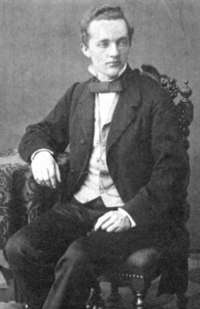Louis Paulsen
Louis Paulsen (15 January 1833 in Gut Nassengrund near Blomberg, Principality of Lippe – 18 August 1891) was a German chess player. In the 1860s and 1870s, he was among the top five players in the world. He was a younger brother of Wilfried Paulsen.

Paulsen was one of the first players to challenge the notion that an attack could be constructed out of brilliance. He put forward the idea that any brilliant attack would have failed against correct defence. His ideas were grasped by Wilhelm Steinitz, who declared that attack and defence have equal status, and particularly by Aron Nimzowitsch, who listed Paulsen among his six greatest "purely defensive players". Paul Morphy and Paulsen were early masters of the game and of blindfold chess; they were capable of playing 10 blindfold games at the same time without any major errors. In 1862 Paulsen challenged Adolf Anderssen for the world championship. The eight-game match was a tie and Anderssen remained an unofficial world champion.[1] Paulsen defeated Anderssen in matches in 1876 and 1877.[2]
Paulsen has many contributions in the opening theory such as the Sicilian Dragon, the Sicilian Paulsen Variation, French Defense Paulsen Attack and Vienna Game Paulsen Variation. He played in the final match of the 1857 First American Chess Congress, losing to Paul Morphy five games to one with two draws.[3]
Paulsen pawns
Paulsen pawns is a term coined by Nimzowitsch for a restricted pawn centre with two pawns on squares d6 and e6 for Black or d3 and e3 for White, often coupled with an open c-file. This restricted centre makes it difficult for the opponent to whip up a quick attack by advancing his centre. Paulsen pawns are the stalwart of the Paulsen Variation of the Sicilian Defence.
Chess opening contributions
Sicilian Dragon
The modern form of the Dragon was originated by Paulsen around 1880.[4] It was played frequently by Henry Bird that decade, then received general acceptance around 1900. In chess, the Dragon Variation[5] is one of the main lines of the Sicilian Defence and begins with the moves:
In the Dragon, Black fianchettoes his bishop on the h8–a1 diagonal. The line is one of the sharpest variations of the Sicilian Defence, making it one of the sharpest of all chess openings.[6]
Sicilian Defence, Paulsen Variation
A less famous variation in the Sicilian Defence is the Paulsen Variation. The line goes as follows:
- 1.e4 c5 2.Nf3 e6 3.d4 cxd4 4.Nxd4 a6
or
- 1.e4 c5 2.Nf3 e6 3.d4 cxd4 4.Nxd4 Nc6 5.Nc3 a6
Paulsen Attack in the Scotch Game
The move 7.Bb5 in the Scotch Game is associated with Paulsen's name, as the Paulsen Attack: 1.e4 e5 2.Nf3 Nc6 3.d4 exd4 4.Nxd4 Bc5 5.Be3 Qf6 6.c3 Nge7 7.Bb5.
Paulsen Variation in the Vienna Game
After 1.e4 e5 2.Nc3 Nc6, the move 3.g3 is known as the Paulsen Variation in the Vienna Game. Paulsen played the move five times in the Vienna 1873 chess tournament.[7]
References
- World Chess Championship : 1862 Anderssen vs. Paulsen
- The chess games of Louis Paulsen
- "Participants in the 1st American Chess Congress". edochess.ca. Retrieved May 28, 2018.
- Hooper & Whyld (1996), p. 114. Dragon Variation.
- "Sicilian, Dragon Variation (B70)". Chess openings. Chessgames.com. Retrieved 2007-04-25.
- Wolff, Patrick (1997). "9". The Complete Idiot's Guide to Chess. Patrick Wolff. p. 147. ISBN 0-02-861736-3.
- Hooper & Whyld (1996), p. 293. Paulsen Variation.
- Hooper, David; Whyld, Kenneth (1996) [First pub. 1992]. The Oxford Companion to Chess (2nd ed.). Oxford University Press. ISBN 0-19-280049-3.
External links
- Louis Paulsen player profile and games at Chessgames.com